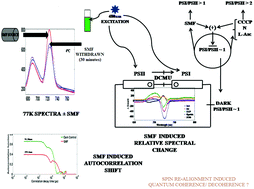Static magnetic field (SMF) sensing of the P723/P689 photosynthetic complex†
Abstract
Moderate intensity SMF have been shown to act as a controller of the protic potential in the coherent milieu of the thylakoid membranes. SMF of the order of 60–500 mT induces memory-like effect in photosystem I (PSI, P723) emission with a correlated oscillation of photosystem II (PSII, P689) fluorescence emission at a temperature of 77 K. The observed magnetic perturbation that affects the thylakoid photon capture circuitry was also found to be associated with the bio-energetic machinery of the thylakoid membranes. At normal pH, SMF causes an enhancement of PSI fluorescence emission intensity (P723/P689 > 1), followed by a slow relaxation on the removal of SMF. The enhancement of the PSI fluorescence intensity also occurs under no-field condition, if either the pH of the medium is lowered, or protonophores, such as carbonyl cyanide chlorophenylhydrazine or nigericin are added (P723/P689 ≥ 2). If SMF was applied under such a low pH condition or in the presence of protonophore, a reverse effect, particularly, a reduction of the enhanced PSI emission was observed. Because SMF is essentially equivalent to a spin perturbation, the observed effects can be explained in terms of spin re-organization, illustrating a memory effect via membrane re-alignment and assembly. The mimicry of conventional uncouplers by SMF is also notable; the essential difference being the reversibility and manoeuvrability of the latter (SMF). Finally, the effect implies numerous possibilities of externally regulating the photon capture and proton circulation in the thylakoid membranes using controlled SMF.


 Please wait while we load your content...
Please wait while we load your content...